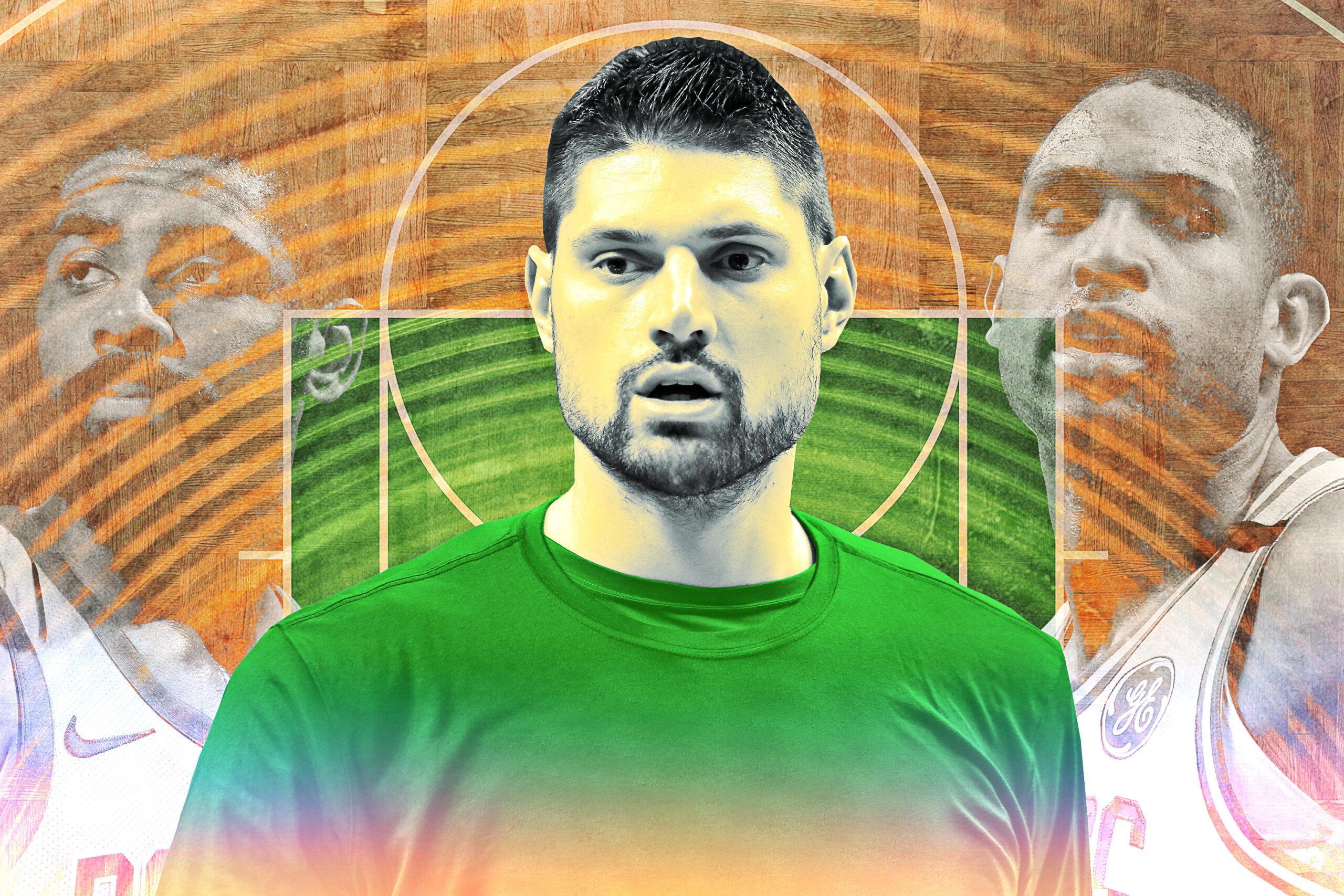
The Celtics need to change the perception of their franchise. Everything has gone wrong for them over the past 12 months. They didn’t trade for Anthony Davis, and will reportedly lose Kyrie Irving and Al Horford in free agency. No one is calling them the future of the Eastern Conference anymore. The good news for Boston is that it doesn’t have to start over. It still has one of the best cores in the league, headlined by two former no. 3 overall picks in Jayson Tatum and Jaylen Brown. The departures of Horford and Kyrie won’t matter if Tatum and Brown can play like All-Stars. The most important thing the Celtics can do this offseason is to put the right players around their two young wings.
Boston could be a player in free agency. It will have $25 million to $34 million in cap room, enough to sign a player with seven to nine years of experience to a max contract, depending on whether it renounces the cap hold on restricted free agents Terry Rozier and Daniel Theis. The Celtics won’t be able to replace Kyrie and Horford. They have been linked to point guards like Kemba Walker and centers like Nikola Vucevic, but they won’t be able to sign both.
The question is not whether Vucevic or Walker is the better player; neither is good enough to be the best player on a championship team. The question is which one makes more sense alongside Tatum and Brown. Neither Boston wing played up to his potential last season. Young players, especially ones taken in the top three, are supposed to get better every season. Yet both took massive steps back after being the two leading scorers on a team that made it to Game 7 of the Eastern Conference finals. Tatum went from dunking on LeBron James to being an afterthought in the offense. Brown was demoted to the bench:
The Celtics’ Young Wings Take a Step Back
Tatum, who turned 21 in March, will want a bigger role in the offense next season. He was on the path to stardom after his breakout rookie campaign. He was featured in GQ at 20, and just signed a shoe deal with Jordan Brand. He has the tools to be a big-time scorer. At 6-foot-8 and 208 pounds, Tatum has the size of a forward and the offensive skill set of a guard. He can create his own shot against even the best defenders. He’s a great 3-point shooter (career 40.0 percent on 3.5 attempts per game) who can put the ball on the floor and shoot off the dribble. But where Tatum struggles is in his shot selection. He doesn’t shoot many 3s or get to the line much. He settles for tough midrange jumpers instead of attacking the rim, and he’s still learning how to balance between hunting for his own shot and moving the ball. His ceiling will depend on whether he improves in those areas, but he can still be a good player even if he doesn’t.
Brown, who turns 23 in October, has even less reason to want a smaller role. He is up for an extension on his rookie contract and will be a restricted free agent next offseason if he doesn’t sign one before the October deadline. He’s not quite as skilled as Tatum, but he’s far more athletic. At 6-foot-7 and 220 pounds, he’s a good 3-point shooter (career 36.5 percent on 3.2 attempts per game) with the physical tools to bully his way to the rim and defend players at all five positions. Brown and Tatum complement each other well. They cause a lot of matchup problems on the perimeter for defenses who don’t have two wings with size. It just didn’t matter last season because both spent most of their time playing off the ball.
Boston doesn’t need a point guard who will take away opportunities from Tatum and Brown. It needs a center who will allow them to do more with the opportunities they receive. Horford was a bigger factor than Kyrie in Tatum’s and Brown’s development. They don’t necessarily need to play with a great point guard; they can already create their own shots. What they need is a center who can space the floor and make plays for them. Both young wings were far more effective on offense last season with Horford on the floor:
The Al Horford Effect
Horford’s scoring (13.6 points per game last season) is the least important part of his game. His key numbers are assists (4.2 per game) and 3-point attempts (3.0 per game). Playing with a big man who can space the floor and pass the ball is a luxury. Guards can attack the rim without worrying about the opposing center because they had to guard Horford on the perimeter. Horford can also push the ball in transition and create structure in the half court. He can find shooters at the 3-point line and hit cutters out of the post. He was the real magician in Boston, not head coach Brad Stevens. His ability to simplify the game is why Isaiah Thomas, Avery Bradley, and Jae Crowder all had their best seasons in Boston.
Tatum and Brown aren’t polished enough yet to thrive in every kind of environment. They can’t consistently score through cracks in the defense and make cross-court passes on the move to punish teams for packing the paint. Those are the kinds of plays they had to make when Horford was spelled by less skilled big men like Aron Baynes, who was traded on draft night to the Suns, and Theis, a restricted free agent, at center.
Finding a replacement for Horford won’t be easy. There were only six other centers who averaged more than 3.0 assists and 2.0 3-point attempts per game last season: Karl-Anthony Towns, Joel Embiid, Marc Gasol, Nikola Jokic, DeMarcus Cousins, and Vucevic. Vucevic, the Orlando Magic center, isn’t as big a name as any of the other players on this list, but he’s made a massive leap over the past two seasons. He’s a far more appealing target than either Gasol, who is six years older than him, or Cousins, who has a long history of locker room issues and tore his quad and ruptured his Achilles in the past two seasons.
Vucevic is entering free agency at the perfect time. He’s a 28-year-old coming off a season when he averaged career highs in points (20.8), rebounds (12.0), assists (3.8), and true shooting percentage (57.3), made his first All-Star team, and led Orlando to the playoffs for the first time since 2012. Vucevic, at 7 feet and 260 pounds, has always been able to score. His improvements have come as a passer and 3-point shooter—he shot 36.4 percent from 3 on 2.9 attempts per game last season. He won’t come cheap, but Orlando may not want to give him a huge long-term contract given that it just drafted another center (Mohamed Bamba) at no. 6 overall in 2018.
Signing Vucevic would also help their one remaining max free agent, Gordon Hayward. The Celtics could start Vucevic next to Brown, Tatum, Hayward, and Marcus Smart in a lineup without a traditional point guard. Vucevic is skilled enough to be the fulcrum of the offense while the perimeter players all share ballhandling duties. That type of lineup would also allow Hayward to play more of a point forward role and set up Tatum and Brown instead of competing with them for touches on the wing next to a star point guard. Hayward wasn’t the same player last season, his first after a devastating leg injury. He wasn’t confident around the rim, and looked to pass rather than score through traffic. The one thing Hayward could still do well was pass. He’s a 6-foot-8 wing who can see over the defense and make plays on the move. On a per-36-minute basis, he averaged the fourth-fewest points in his career (15.9) but the second-most assists (4.7).
The downside of signing Vucevic is what he would do to Boston’s defense. He’s bigger than Horford, but he doesn’t have the same combination of mobility, toughness, and basketball IQ. Two-way play is the secret sauce to Horford’s playoff success. Not only he is great on offense, he’s also one of the best rim protectors and most versatile defenders in the league. He has guarded Giannis Antetokounmpo and Joel Embiid in the playoffs. Vucevic is coming off the best defensive season of his career, wherein he anchored a top-10 defense under new Magic head coach Steve Clifford, but he would struggle to guard Embiid and would have no chance against Giannis. Boston would go from building its defense around its center to protecting him. Brown, not Vucevic, would get the assignment on Giannis, and the Celtics would have to send doubles at Embiid.
There may be a playoff ceiling for a team with Vucevic, but that shouldn’t matter to the Celtics. Their success will be determined more by how well Tatum and Brown develop. Supersized wings with a 3-point shot and two-way ability are the most valuable players in the league. The Celtics would have two, both under the age of 23. A playoff team with Brown and Tatum each averaging more than 20 points per game would at least be fun. Having two primary scorers on rookie deals allows a team to spend more in free agency, in the same way having a quarterback on a rookie deal does in the NFL. The timing works out well, too. Hayward will likely be in the last season of his contract next season (2020-21), before Tatum needs an extension on his rookie deal, which would potentially give them tons of cap space in the summer of 2021 even with Vucevic on the books.
One interesting comparison for a Vucevic deal is the four-year, $80 million contract the Rockets gave Ryan Anderson in the same offseason they lost Dwight Howard. It was an overpay, but it was also a crucial step in changing their reputation after a miserable season in which they won 41 games and lost in the first round. Anderson, along with fellow free-agent signing Eric Gordon, opened up the floor and made life easier for James Harden, who finished second in the MVP race. Tatum and Brown aren’t anywhere as good as Harden, which makes their need for floor spacing only more important.
Despite everything that has happened since last year’s playoff run, the Celtics still have a promising future. Tatum and Brown form the league’s best young wing combo. They are bigger and better defensively than D’Angelo Russell and Caris LeVert, if those two even stay together in Brooklyn; they are better shooters than Brandon Ingram and Lonzo Ball; and they’re more skilled than Aaron Gordon and Jonathan Isaac. They should be the backbone of a playoff contender for the next decade. The key for Boston is to maintain its recent hit rate in the draft with some combination of this year’s rookies (Romeo Langford, Grant Williams, Carsen Edwards, and Tremont Waters) and their future picks, including one from a rebuilding Memphis team that is only top-six protected in 2020 and unprotected in 2021. That’s where a stretch big man like Vucevic becomes so important. One of the most underrated aspects of drafting well is putting young players in positions to succeed.
Things change fast in the NBA. The Celtics, as hard as it is to believe, could be a premier free-agent destination again if Tatum and Brown become All-Stars. The most important thing they can do this offseason is bring in guys who can help that process.

